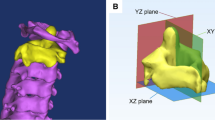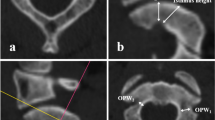Abstract
Introduction
Surgery of cervical spine steadily requires realizing posterior osteosynthesis. The anchoring of instrumentation in C2 steadily constitutes an important stake of prognosis. Pedicle screwing is one of the best options and remains associated with a low morbidity. The aim of this CT study is to provide, from a wide population, the descriptive anatomical parameters of C2 pedicles. The data enable this analysis of feasibility of C2 pedicles screwing.
Materials and methods
A continuous and retrospective series have explored 100 CT scans of the cervical spine without finding C2 fracture. The software OSIRIX v5.0.2 has been used. The dimensions of the pedicles in C2 as length, diameter, and distance from the vertebral foramens have been measured from the preset posterior entry point. Their orientation has been described in the axial and sagittal plan by the pedicle transverse angle, the sagittal angle and the pedicle–lamina angle used as a visible mark during the procedure. At least, the feasibility of pedicle screwing has been evaluated using a diameter criterion higher than 4 mm.
Results
The dimensions analysis of 200 studied pedicles has found an average length as 26.18 mm, an average diameter as 5.18 mm and an average distance between the entry point and the vertebral foramen as 9.06 mm. Their orientations have an average PTA as 36.6° and a SA as 25.8°. The average of the PLA was 81.3. The screwing feasibility has been evaluated as 92.5 % in the whole series.
Conclusion
These morphological data come from a large series give some help for the C2 pedicle screwing preoperative planning. These lean on 3D measures but also on accessible mark during the procedure and despite the difference of the patient orientation. A CT preoperative planning of the pedicle screwing remains essential because more than 7 % of the pedicles have a diameter lower than 4 mm.




Similar content being viewed by others
References
Benzel EC (1996) Anatomic consideration of C2 pedicle screw placement. Spine 21(19):2301–2302
Borne GM, Bedou GL, Pinaudeau M (1984) Treatment of pedicular fractures of the axis. A clinical study and screw fixation technique. J Neurosurg 60(1):88–93
Elliott RE, Tanweer O, Boah A, Smith ML, Frempong-Boadu A (2012) Comparison of safety and stability of C2 pars and pedicle screws for atlantoaxial fusion: meta-analysis and review of literature. J Neurosurg Spine 17(6):577–593
Helgeson MD, Lehman RA, Dmitriev AE, Kang DG, Sasso RC, Tannoury C, Riew KD (2011) Accuracy of the freehand technique for 3 fixation methods in the C-2 vertebrae. Neurosurg Focus 31(4):E11
Howington JU, Kruse JJ, Awasthi D (2001) Surgical anatomy of the C-2 pedicle. J Neurosurg 95(1):88–92
Judet R, Roy-Camille R, Saillant G (1970) Fracture du rachis cervical. In: Masson (ed) Actualités de chirurgie orthopédique de l’Hospital Raymond-Poincaré, 8th edn. Masson, Paris, pp 174–195
Koller H, Hitzl W, Acosta F, Tauber M, Zenner J, Resch H, Yukawa Y, Meier O, Schmidt R, Mayer M (2009) In vitro study of accuracy of cervical pedicle screw insertion using an electronic conductivity device (ATPS part III). Eur Spine J 18(9):1300–1313
Lee KH, Kang DH, Lee CH, Hwang SH, Park IS, Jung JM (2011) Inferolateral entry point for C2 pedicle screw fixation in high cervical lesions. J Korean Neurosurg Soc 50(4):341–347
Lehman RA Jr, Dimitriev AE, Helgeson MD, Sasso RC, Kulko TR, Riew KD (2008) Salvage of C2 pedicle and pars screws using the intralaminar technique: a biomechanical analysis. Spine 33(9):960–965
Naderi S, Arman C, Güvençer M, Korman E, Senoğlu M, Tetik S, Arda N (2004) An anatomical study of the C-2 pedicle. J Neurosurg Spine 1(3):306–310
Pang D, Thompson DN (2011) Embryology and bony malformations of the craniovertebral junction. Childs Nerv Syst 27(4):523–564
Rosset A, Spadola L, Pysher L, Ratib O (2006) Informatics in radiology (infoRAD): navigating the fifth dimension: innovative interface for multidimensional multimodality image navigation. Radiographics 26(1):299–308
Savage JW, Limthongkul W, Park HS, Zhang LQ, Karaikovic EE (2011) A comparison of biomechanical stability and pullout strength of two C1–C2 fixation constructs. Spine J 11(7):654–658
Smith ZA, Bistazzoni S, Onibokun A, Chen N-F, Sassi M, Khoo LT (2010) Anatomical considerations for subaxial (C2) pedicle screw placement: a radiographic study with computed tomography in 93 patients. J Spinal Disord Tech 23(3):176–179
Xu R, Nadaud MC, Ebraheim NA, Yeasting RA (1995) Morphology of the second cervical vertebra and the posterior projection of the C2 pedicle axis. Spine 20(3):259–263
Conflict of interest
None.
Author information
Authors and Affiliations
Corresponding author
Rights and permissions
About this article
Cite this article
Ould-Slimane, M., Le Pape, S., Leroux, J. et al. CT analysis of C2 pedicles morphology and considerations of useful parameters for screwing. Surg Radiol Anat 36, 537–542 (2014). https://doi.org/10.1007/s00276-013-1233-y
Received:
Accepted:
Published:
Issue Date:
DOI: https://doi.org/10.1007/s00276-013-1233-y




